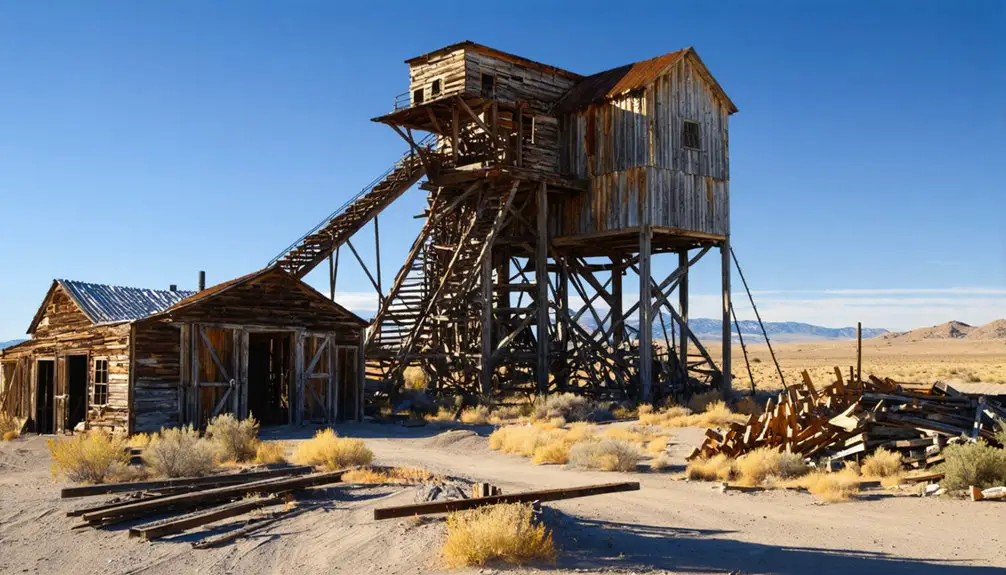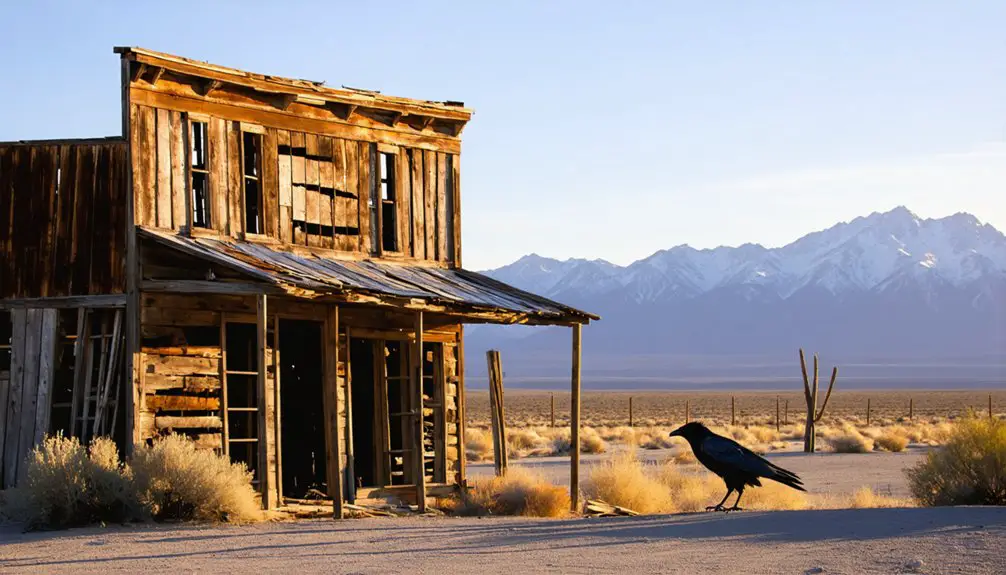You’ll find the ghost town of Broken Hills in Mineral County, Nevada, where Joseph Arthur and James Stratford’s 1913 silver-lead ore discovery sparked one of Nevada’s last significant mining rushes. Despite initial promise and $900,000 in total production, water scarcity at $2.50 per barrel and George Graham Rice’s fraudulent investment schemes led to the town’s decline. Today, only foundations and Matt Costello’s grave remain, marking a settlement where dreams of riches turned to dust.
Key Takeaways
- Broken Hills was a silver-lead mining settlement established in 1913, reaching its peak population of several hundred residents between 1915-1920.
- The mining district produced $900,000 in ore before operations ceased in 1940, hampered by water scarcity and economic challenges.
- Located in Mineral County at 5,371 feet elevation, the site retains only foundations and dirt pits from its mining-era structures.
- The town featured basic amenities including a hotel, saloons, stores, and a school during its brief period of activity.
- Matt Costello’s grave remains the most prominent cultural artifact, while desert vegetation gradually reclaims the abandoned settlement’s remnants.
The Discovery That Started It All
Two English prospectors, Joseph Arthur and James Stratford, made a pivotal discovery of silver-lead ore in Broken Hills, Nevada in 1913.
Unlike many Nevada ore discoveries that centered on gold, their find marked one of the last significant mining rushes in the state’s prospecting era. They quickly claimed the most promising sites in the area, limiting opportunities for other prospectors who’d hoped to strike it rich.
Breaking from Nevada’s gold rush pattern, this silver-lead discovery marked a final chapter in the state’s great prospecting age.
While their discovery sparked a rush within six months, bringing hopeful miners to this remote location, the prospector challenges proved intimidating. Like many living ghost towns of Nevada, some original structures from this era still stand today. The site was later purchased by George Graham Rice, a notorious fraudster who would ultimately contribute to the town’s downfall.
Between 1913 and 1920, Arthur and Stratford’s mining efforts yielded only $68,000 in silver-lead ore revenue – about $1 million in today’s money. This modest return foreshadowed the town’s eventual fate as another Nevada ghost town.
Mining Operations and Economic Impact
Mining operations at Broken Hills proved challenging from the start, despite the initial promise of rich silver-lead ore deposits. While founders Arthur and Stratford extracted $68,000 in ore by 1920, subsequent operators struggled to achieve economic sustainability. Joseph Arthur and Stratford made their groundbreaking discovery in 1913, marking the beginning of mining activities in the district.
Even George Graham Rice’s substantial $75,000 investment yielded minimal returns, highlighting the district’s operational challenges.
The town’s mining technology evolved with Penelas Mining Company’s 50-ton cyanide mill, but water scarcity at $2.50 per barrel hampered efficiency. The mine featured two major shafts, with the Broken Hills shaft reaching 600 feet deep and the Belmont shaft extending several hundred feet.
You’ll find the area’s most successful period occurred from 1935-1940, generating $180,000 in production. Despite supporting infrastructure including stores, hotels, and boarding houses, the settlement never achieved the boom status of other mining towns.
Total district production reached $900,000 before operations ceased in 1940.
Life in the Silver Rush Settlement
Life in Broken Hills reached its peak between 1915 and 1920, when several hundred residents called this remote silver settlement home.
You’d find a town equipped with basic necessities: a hotel, saloons, stores, and a school. Despite harsh conditions, including water costing $2.50 per barrel, community cohesion remained strong among miners and their families.
Despite challenging desert life and costly resources, Broken Hills maintained a tight-knit community spirit around its modest but essential establishments.
Your daily life would’ve centered around mining activities, with social gatherings at the local saloons offering respite from the challenging desert environment. A stage line to Virginia City provided vital connections to civilization and commerce.
You could’ve stayed at the boarding house or one of seven cabins, though living conditions were austere. The town experienced a revival in 1926 when Quartz Mountain operations boosted local mining activity.
While the post office operated sporadically from 1920 to 1935, the town’s fortunes ebbed and flowed with mining successes.
Notable Characters and Their Influence
You’ll find that Broken Hills’ early history was shaped by Joseph Arthur and James Stratford, two English miners who worked the initial claims from 1913-1920 but netted only $68,000 for their efforts.
Similar to modern-day Batty where residents must drive 75 miles to reach grocery stores, the mining settlement was extremely isolated from basic amenities. Their modest success attracted controversial promoter George Graham Rice, who transformed the operation into a speculative venture that ultimately led to his imprisonment for defrauding investors. The venture yielded a mere seven thousand dollars in revenue despite Rice’s $75,000 investment.
The tension between genuine producers like Arthur and Stratford versus opportunistic promoters like Rice would come to define Broken Hills’ legacy as a “broken wallet” town rather than a prosperous mining settlement.
Mining Founders’ Bold Vision
When silver-lead ore deposits were discovered in 1913, Englishmen Joseph Arthur and James Stratford established Broken Hills with ambitious plans for mining wealth.
The founders’ ambition led them to stake claims on the most promising sites, though their mining innovation yielded only $68,000 in ore value – about $1,067,000 in today’s money.
You’ll find their vision for prosperity fell short, as they eventually sold their claims to promoter George Graham Rice after disappointing returns.
While they’d built the foundations for a community that would grow to include stores, a hotel, and a school, their early claim-staking actually limited the town’s growth potential.
Their legacy shaped Broken Hills’ destiny as a short-lived mining town that never achieved the grand success they’d envisioned.
After years of struggle, the area saw its final decline when the post office closed in February 1935.
Rice’s Speculative Mining Venture
After acquiring the struggling claims from Arthur and Stratford in 1920, promoter George Graham Rice launched an aggressive campaign to attract investors to Broken Hills.
Born Jacob Herzig, Rice’s speculative practices had already earned him notoriety through his Nevada Mining News Bureau and L.M. Sullivan Trust Company, which promoted worthless mine stocks.
You’ll find Rice’s tenure at Broken Hills marked by stark financial discrepancies. While he collected $75,000 from hopeful stockholders, the mine produced a mere $7,000 in revenue.
His pattern of self-promotion over productive mining led to significant investor losses and contributed to the town’s ultimate decline. The mine shipped all extracted ore to the Bruners 50-ton mill, located 12 miles away.
Though stockholders launched an investigation, Rice avoided consequences when he landed in prison for unrelated mail fraud, leaving Broken Hills to fade into ghost town status.
Promoters Versus Producers Battle
The battle between mining promoters and producers at Broken Hills highlighted a stark contrast in operational approaches.
You’ll find promoter motivations exemplified by George Graham Rice, who acquired the claims after investing $75,000 of stockholder money but generated only $7,000 in revenue. His background in mail fraud and check forgery shaped his focus on selling inflated stocks rather than developing sustainable mining operations.
Producer challenges faced by founders Joseph Arthur and James Stratford revealed a different story. These English prospectors discovered silver-lead ore in 1913 and spent five years extracting $68,000 worth of ore.
While their yield remained modest, they concentrated on actual mining rather than speculation. The clash between Rice’s promotional schemes and the founders’ production-focused efforts ultimately contributed to Broken Hills’ downfall.
Geographic Features and Natural Setting
Situated in Mineral County, Nevada at 5,371 feet above sea level, Broken Hills occupies a distinctive position within the Great Basin’s vast network of mountain ranges and desert basins.
You’ll find the ghost town nestled against the Broken Hills Range, where stark topographic features define the rugged landscape.
The site’s natural vegetation reflects its high desert environment, with hardy desert scrub and sparse grasses adapted to the arid conditions.
You’ll experience dramatic temperature swings typical of Nevada’s high desert, while the surrounding terrain showcases dusty hills and mineralized rock formations.
Access is via a dirt road off State Route 361, though you’re looking at a 1.5-hour drive to the nearest services in Hawthorne.
The area’s geology, rich in gold-bearing ore, determined both the town’s rise and eventual abandonment.
The Rise and Fall of a Mining Dream

Prospectors Joseph Arthur and James Stratford launched Broken Hills’ mining saga in 1913 when they discovered rich silver-lead ore deposits in the area.
Though their veins yielded impressive concentrations up to 100 oz/ton, they tightly controlled the best claims, limiting the town’s growth potential.
You’ll find that despite early promise and the development of stores, hotels, and schools, Broken Hills never achieved true boomtown status.
Economic downturns plagued the settlement after promoter George Graham Rice’s failed investment scheme, and water scarcity at $2.50 per barrel crippled mining operations.
While the nearby Quartz Mountains silver rush briefly revived hopes in 1926, mining accidents and dwindling profits continued to challenge the remaining miners.
What Remains: A Ghost Town’s Legacy
Today’s visitors to Broken Hills encounter a stark reminder of Nevada’s boom-and-bust mining cycle.
You’ll find mostly foundations and dirt pits where abandoned structures once stood, with roads and paths winding through the desert landscape. Matt Costello’s grave, marked by a headstone and iron fence, stands as the site’s most prominent cultural remnant.
While the town’s commercial heart – including its post office, hotel, and saloon – has vanished, you can still trace the community’s footprint through deteriorated mining shafts and scattered building remnants.
Though the four-story stamp mill survives at nearby Quartz Mountain, Broken Hills itself retains few tangible structures. The desert’s reclamation of this once-bustling settlement serves as a powerful indication of the transient nature of mining boom towns.
Frequently Asked Questions
Are There Any Dangerous Mine Shafts Still Accessible to Visitors Today?
At 140+ feet deep, dangerous mine shafts remain open and accessible. You’ll find numerous unmarked shafts with deteriorating supports, but mine safety experts strongly advise against entering due to collapse risks.
What Was the Average Wage for Miners Working in Broken Hills?
You’d find miners earned roughly $2-5 daily in Broken Hills’ harsh mining conditions, though exact wage history isn’t documented. These wages reflected the dangerous work and primitive technology of early 1900s mining.
Did Any Major Crimes or Shootouts Occur During the Town’s Existence?
Unlike the Wild West tales you’ve heard, there weren’t any documented shootout incidents or major crime statistics in this town. You’ll find only financial fraud by George Graham Rice, who scammed stockholders.
Were There Any Native American Settlements Near Broken Hills Before Mining?
You’ll find no permanent Native American settlements directly at Broken Hills, though Western Shoshone and Paiute tribes used the area seasonally for hunting and gathering, establishing temporary historical settlements in nearby regions.
How Did Residents Get Their Water Supply in This Arid Region?
Thirsty as a fish out of water, you’d rely on imported supplies hauled from Lodi Valley, 10 miles away. Water sources were scarce, with no local irrigation methods available, forcing residents to pay $2.50 per barrel.
References
- https://en.wikipedia.org/wiki/Broken_Hills
- https://www.youtube.com/watch?v=f-76pqtcafw
- https://www.nevadaghosttownsandmininghistory.com/portfolio-2/broken-hills
- https://www.destination4x4.com/broken-hills-mineral-county-nevada/
- http://www.nv-landmarks.com/towns-ab/brokenhills.htm
- https://www.smithsonianmag.com/sponsored/nevadas-living-and-abandoned-ghost-towns-180983342/
- https://nvtami.com/2022/06/29/gabbs-ghost-town-trip/
- https://westernmininghistory.com/mine-detail/10072141/
- https://ronhess.info/docs/report7_history.pdf
- https://forgottennevada.org/sites/silverhill.html



